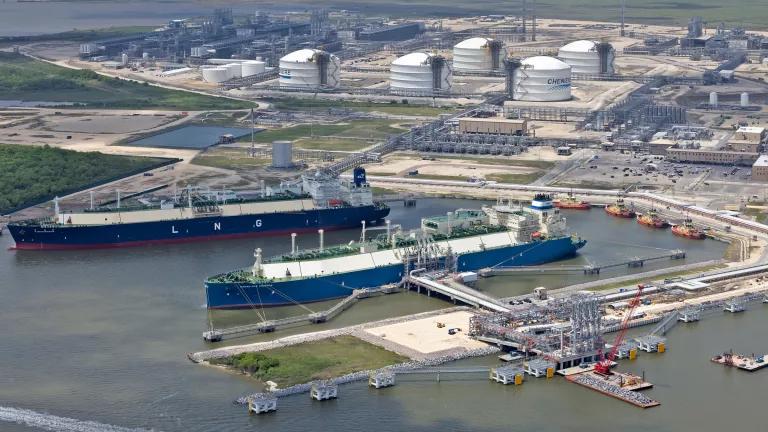"Hydrogen-Ready" LNG Infrastructure: An Uncertain Way Forward
It's important to discuss what “hydrogen-ready" actually means (and what it doesn’t) in the context of LNG and the implications of proposed transitions in Europe and Asia.

An LNG regasification terminal in Portugal
TGE Gas Engineering, CC BY-SA 4.0
Over the last several years, interest in hydrogen has snowballed into a global phenomenon. Many hope that hydrogen can replace fossil fuels as a climate-friendly alternative, and the buzz grew even stronger in 2022 following Russia’s invasion of Ukraine. Many countries (notably in Europe) have grown increasingly intent on securing new sources of gas supplies to diversify away from Russian gas, and they plan on rapidly increasing the use of hydrogen to replace fossil gas in some parts of their economy.
The European Union (E.U.) has begun constructing multiple new liquefied natural gas (LNG) terminals to ramp up gas imports from faraway sources such as the United States and Qatar, and hydrogen import-export projects are already developing in some of the top LNG importing countries in Asia Pacific, such as South Korea and Japan. Importers in both of these regions (Europe and Asia Pacific) are branding this build-out as consistent with climate targets, claiming that their LNG terminals are “hydrogen-ready”—i.e., they could eventually be converted to hydrogen and cease using fossil fuels.
But these developments make it important to discuss what “hydrogen-ready" actually means (and what it doesn’t) in the context of LNG and the implications of this proposed transition. As we discuss below, this theoretical transition is fraught with an array of technical uncertainties and risks locking countries into expensive energy pathways that undermine climate progress.
We raise some of the key components—and fundamental feasibility considerations—that should guide policymaking and designing of a global hydrogen industry.
Background: Two major transition pathways are being contemplated
“Hydrogen-ready" LNG infrastructure needs to consider how best to globally transport hydrogen in the future. The two pathways being considered as the most viable are: (1) to liquefy hydrogen (LH2) and ship it in liquefied form; or (2) to convert hydrogen into ammonia then liquefy that ammonia for shipment as a “hydrogen carrier.”
There are immense challenges and risks associated with both of these LNG conversion pathways.
Liquefying hydrogen is challenging and costly: Any transition from LNG to LH2 will be far from seamless
It is important to remember that hydrogen and fossil gas are two fundamentally different gases. Liquefying and shipping hydrogen is very challenging. It requires chilling it to a hyper-cold -253 degrees Celsius. That’s closer to temperatures found in outer space and nearly 100 degrees Celsius colder than temperatures needed to transport LNG. Thus, the process requires significantly more energy than liquefying fossil gas (liquefaction of hydrogen consumes 30 to 40 percent of its energy content as opposed to less than 10 percent for LNG). This has major implications on the costs of the transition from LNG to LH2 and the infrastructure required to transport LH2.
Moreover, hydrogen has a significantly lower liquid energy density than LNG (no more than 42 percent of LNG’s energy density), meaning that for every LNG ship, approximately 2.4 LH2 ships would be needed to deliver the same amount of energy. This adds cost and energy intensity to the shipping process.
Given those challenges, there is now strong consensus among experts that shipping LH2 is unlikely to be a major enterprise
For example, the International Renewable Energy Agency (IRENA) argues that LH2 will only have a niche role in global hydrogen trade, largely due to the high costs and challenges of transport, estimating instead that about half of the hydrogen internationally traded by 2050 would be traded via pipeline, with the other half transported by ammonia ships (i.e., very little LH2 trade). Wood Mackenzie reports that current export-oriented hydrogen projects plan to ship ammonia and not LH2, due to the high costs of the latter. BloombergNEF (BNEF) found that less than 2 percent of announced hydrogen export projects plan to transport hydrogen via liquefied hydrogen.
Furthermore, a recent Fraunhofer Institute study exploring the potential overlap in infrastructure between LNG import and export terminals and their hypothetical LH2 analogues (as these plants don’t exist at present) found that only about 50 percent of initial LNG capital expenditures could be reused (and that is if hydrogen compatible materials are used in the initial LNG terminal construction). It bears noting that these findings are presented with a great deal of uncertainty because there is currently no global market for liquefied hydrogen transport. As a result, there is a lack of familiarity with the practical aspects of handling this fuel at scale. Similarly, the International Energy Agency (IEA) argues that any conversion of existing or planned LNG infrastructure is “technically challenging” and “requires replacement or drastic modification of most of the equipment.”
Despite these major technical and economic uncertainties hurdles, LH2 transit projects are being piloted by large players in the Asia Pacific LNG market, including Japan, Korea, and Australia, while Europe is pressing ahead with expanding LNG infrastructure premised on future repurposing to LH2.
Even assuming a successful conversion to LH2, cost and climate risks loom for importing countries
These infrastructure and operational challenges mean that countries betting on the widespread use of LH2, and making near-term investments to that end, risk locking themselves into what would likely be an expensive hydrogen pathway relative to alternatives. These less expensive pathways include local hydrogen production and/or importing hydrogen gas from closer regions via long-distance pipelines (e.g., from Northern Africa in the European case). For example, the think tank Agora Energiewende calculates that it would be cheaper to produce green hydrogen in the E.U. than to import LH2 by ship from remote places with very cheap green hydrogen resources (e.g., Chile or Australia). Agora also finds that transporting hydrogen gas by long-distance pipeline (say, from North Africa) would be roughly half the price of shipping LH2 to Europe.
LH2 also carries climate risks. Hydrogen is the smallest molecule in the universe and leaks easily. Recent studies are finding that when it leaks into the atmosphere, hydrogen can result in serious climate warming, about 33 times more than carbon dioxide over the first 20 years after it leaks. LH2 is particularly prone to hydrogen leakage because the hyper-cold temperatures that it needs to liquefy may not be easily maintained at all times. This leads to potentially significant quantities of hydrogen “boil-off,” where shares of LH2 reconvert into gas, leaking into the atmosphere and leading to climate warming. A study commissioned by the United Kingdom government—a strong hydrogen proponent, incidentally—concludes that the “worst offender” for hydrogen leakage would be tanker transport of liquid hydrogen, with leak rates double those of the next contender on the list. Heavy reliance on LH2 could therefore come at a cost to our rapidly warming climate.
Transporting ammonia is easier, but important challenges remain
The myriad challenges of LH2 are prompting a shift in discourse: Conversion of LNG assets to ammonia, in lieu of LH2, is making its way to the airwaves. This path is far from perfect, as we will discuss, but there are a range of benefits to this course relative to LH2. Shipping of ammonia is considered one of the most likely modes of shipping hydrogen overseas because ammonia is much easier to liquefy than either hydrogen or fossil gas. Ammonia also has a higher liquid energy density than hydrogen (though still lower than that of LNG), which means that lower quantities of ammonia would be needed relative to LH2 to meet energy needs.
Unlike hydrogen, a global market for ammonia transport via ship already exists today, making the prospect of exporting ammonia as a hydrogen carrier likely more viable than exporting liquid hydrogen at present. Both BNEF and the Fraunhofer Institute found that conversion of LNG terminals into ammonia terminals is technically and financially feasible. Their findings show that this conversion would require only a relatively modest 6 to 20 percent additional capital expenditure, depending on terminal design and how early in the planning process conversion to ammonia is considered. Those figures are significantly lower than the cost of retrofitting to handle LH2.
Given those prospects, LNG terminals currently under construction in Europe like Brunsbüttel, Stade, and Wilhelmshaven are being developed to be “ammonia-ready.”
However, major challenges remain that should give decision makers pause before betting on a major LNG to ammonia conversion campaign. Despite the more favorable technical considerations, development of an ammonia economy faces potential economic, logistical, and safety hurdles that the IEA argues can “affect the technical and economic attractiveness of the repurposing case.”
Most ammonia today is used as a feedstock in large-scale industrial processes, like fertilizer production, rather than as a fuel. There is potential for using ammonia as a fuel in maritime shipping, but ammonia-fueled tankers have yet to be deployed at scale. Otherwise, there are narrow opportunities for ammonia to be used directly outside of those two main applications. This means that transported ammonia would likely have to be cracked back into hydrogen, which can then be utilized in its various applications (like steel production, industrial process heating, trucks, etc.). This entails a very energy-intensive process: It requires producing ammonia from hydrogen in the exporting country (an already energy-intensive process), transporting the ammonia, and cracking it back into hydrogen in the destination country (resulting in a very low estimated round-trip efficiency of 30 to 40 percent, depending on subsequent hydrogen use case). It also requires expensive cracker equipment: The Fraunhofer Institute caveats its findings by noting that its study concerning the conversion of LNG terminals to ammonia does not include costs (both monetary and in energy) of cracker construction and operations.
Development of ammonia terminals also entails siting uncertainties and considerations: It requires the added logistical consideration of co-siting with crackers to convert ammonia back into hydrogen (with its significant energy losses), or otherwise proximity to ammonia demand centers if ammonia is to be used directly in its narrow set of applications. The location of those demand centers may have little overlap with the “parent” LNG infrastructure, adding further challenges to the LNG to ammonia conversion enterprise.
Furthermore, ammonia is both a corrosive and toxic compound that raises safe handling concerns in its transport that differ drastically from the relatively safer handling standards for more conventional fossil fuels like LNG. Many European countries already have regulations around the transport of ammonia that are justifiably stricter than those in place for fossil gas, adding another layer of logistical complexity to this posited transition.
The risks of exacerbating fossil fuel lock-in are real: Prudence is an imperative
Hydrogen targeted at hard-to-electrify applications has an important role to play as a decarbonization lever.
However, the global hydrogen shipping landscape is beginning to take shape on an unsteady technical and scientific foundation. The speed and scale at which countries are beginning to lean into shaky and expensive, supposedly “hydrogen-ready” LNG transport methods are cause for concern. Considering the array of risks and uncertainties, much more caution is needed.
Policymakers should instead lean into tried-and-true solutions such as renewable energy, energy efficiency, and electrification, while prioritizing locally produced green hydrogen for targeted sectors. In parallel, rigorous and transparent investigations of the economic, technological, climate, and safety implications of a transition from LNG to either LH2 or ammonia should be carried out before expanding LNG infrastructure premised on this transition.
Prudence is key to prevent the “hydrogen-ready” branding from becoming a guise to perpetuate global reliance on fossil fuels and leading to multibillion dollars of stranded fossil fuel assets.




